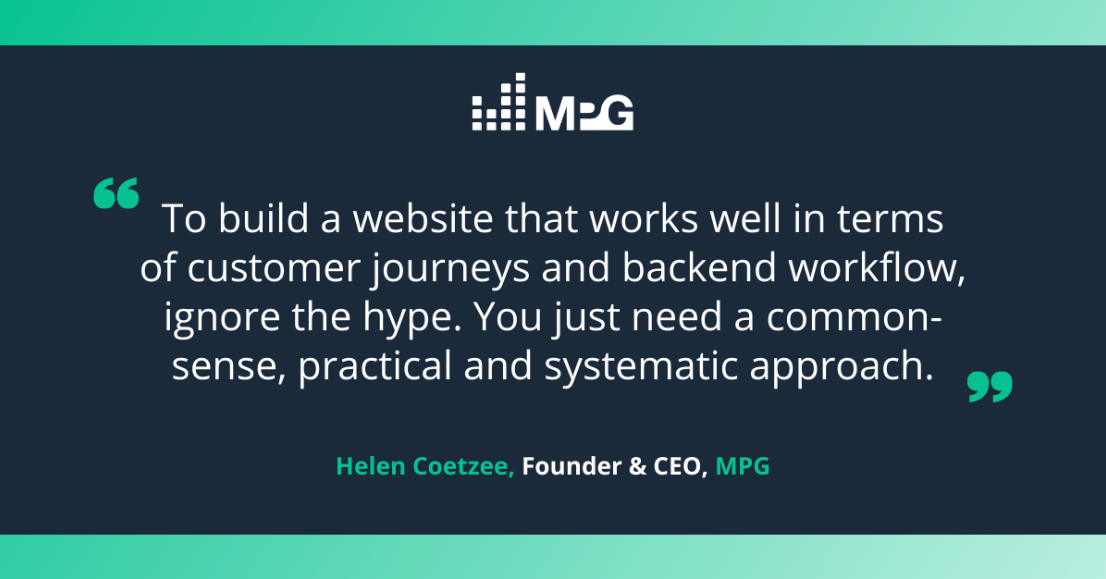Building a high-performance website for a resilient marketing function: a practical guide
In the last MPG Insights article, we covered the role your marketing website plays in ensuring you have a resilient marketing function - and therefore a resilient business. This week, we’re sharing a practical guide to building a high-performance website. Here are our recommendations for following a common-sense, practical and systematic approach to building and maintaining a website that will deliver strong marketing results, and strengthen your business:

#1 Process, process, process
We can’t emphasise enough how important process is - in every area of marketing. If you follow the right process, you’ll get good results.
Mapping and following processes can sometimes feel tedious, but creating a step-by-step approach to building, maintaining and enhancing your website, and then following through consistently with rigour and attention to detail, is what will get you where you need to be.
Like so many necessary things, having a high-performance website is 10% inspiration, and 90% perspiration!
Here we share MPG's step-by-step processes focused on ensuring you get the right website built in the first place, with a downloadable resource of the processes that Team MPG has used time and time again, for consistently good results.
DOWNLOAD YOUR COPY OF THE STEP-BY-STEP PROCESSES
Once you have the right website, built in the right way, including the customer journeys and functionality your customers and your team needs, frequent website reviews and ongoing optimisation should be baked into your ongoing marketing performance review and marketing channel optimisation procedures. This will rely on
-
Google Analytics, or a similar tool - set up in the right way
-
A marketing performance dashboard - which we recommend you build in Looker Studio
#2 Optimising for conversions
Conversion rate optimisation (CRO) isn’t only needed on your web pages focused on registrations, subscriptions and lead capture. Here are the four main areas of your website where CRO plays a very important role:
(1) Your homepage
This is where you make your first impression with many of your visitors and should clearly articulate your value proposition. Your unique selling point (USP) and value-focused benefits for your customers need to be very clearly and simply laid out high up on this page.
Your homepage should also include clear signposting to further content and information to keep your web visitors clicking deeper into your site, including prominent CTAs pointing to conversion-focused pages e.g. Subscribe Today, Book Now, Download Brochure etc.
(2) Content pages
Content pages should also be focused on conversions by pointing visitors to:
(a) Lead generation forms for downloadable sales materials e.g. Download Marketing Solutions Prospectus
(b) Lead generation forms to access premium, gated content e.g. Request a Demo
(c) Subscriber acquisition forms (free subscriptions) - where your audience can volunteer their data to have free or sample content emailed to them via a newsletter, or other types of email updates.
(3) Pages displaying your ‘packages and pricing’
Focus on simplifying the process for your user to understand what’s on offer and choose the best option for them. You need to make it easy for them to buy from you!
If there are different categories of purchasers with different prices e.g. for events you may charge vendors more to attend events, make sure you display the prices clearly.
And remember to signpost web visitors from this page to the landing pages dedicated to conversions and including forms…see next point.
(4) Landing pages dedicated to conversions i.e. with forms
These are the pages that need the most attention for CRO and where you should focus your testing efforts. Include eye catching, brand-enhancing visuals and engaging copy that compels the user to complete the form, highlighting the benefits to them of taking the time to complete the form and giving you their data (What’s in it for them to complete the form? What will they get?).
Avoid lengthy forms that request unnecessary information, or requesting the same information multiple times.
#3 Helping potential customers find your website
Search engine optimisation (SEO) is an ongoing process to ensure your site is always ranking well for the keywords that are most relevant to your audience and product.
SEO is influenced by a number of factors like content, time on site, pages visited and device optimisation. Generally speaking, a good website means good SEO. Here are some of the key components of the ‘good website’ as far as Google is concerned. (
1) Content, and UX around your content The accuracy and relevance of your content, frequency of updates, how well your content is tagged, and how seamlessly it aligns to what a visitor is expecting to see (i.e. customer experience), all impact your SEO.
When producing content for your audience, you should always have top of mind both the customer needs and the objective of the content. And then you need to ensure that your marketing campaigns make the most of the content and the overall customer journey you have built.
(2) Technical set up and performance You need to continually review the technical performance of your site. There are many tools out there, such as Lighthouse, which are an easy way to assess this aspect of your site. Here are some of the key things to look out for that will impact technical performance:
-
Images and videos: search engines can’t ‘see’ what an image contains, so make sure that all images on your site contain alt text and captions. It is important to bear in mind that images and videos can sometimes have a negative effect on your SEO - especially when video and image files are large and take a long time to load, or when they are low quality.
-
Mobile responsiveness: if your websites are difficult to read and use on a mobile phone, your SEO will definitely be badly affected. Always consider all elements as they appear on a mobile, such as navigation, size of font, length of text, and usability of forms. Getting this right is a combination of good digital design, good functionality and good front end development.
-
Navigation: specifically for SEO, you need to consider how search engines’ bots crawling your website to create their rankings ‘understand’ what your site is all about. To make this work well, include keywords in your navigation elements such a URLs for specific pages, menu items, CTAs and headings.
SEO covers a lot more than what we have shared here, but what we've covered should help you get the most important ‘fundamentals’ on place!
(3) Back-links (or links from other websites to yours) are a sure-fire way of increasing your ranking - as long as they are linking from relevant sites. That’s because Google considers relevant back-links to be like positive recommendations to your website. Try to encourage advocates such as event speakers and sponsors, authors of articles you publish and partners to add links to your event on their websites, wherever appropriate.
#4 Creating a good customer experience on your website
User experience (UX) of your website will impact your marketing performance, and therefore your business resilience and performance.
The more favourable an interaction your potential user has with your site, the more likely they are to purchase from you and also refer your products to others. The key elements to be mindful of in creating a positive customer experience are:
-
Navigation: the age old adage, ‘don’t make me think’ is well known in the world of UX. Your website user should be able to very quickly and easily find exactly what they are looking for on your site, with minimal effort.
-
Design: when we talk about design, we are not just talking about having lovely imagery on your site. Good site design also includes fonts, colours and imagery that are consistent with your brand guidelines, are visually pleasing in how images are combined with text, and contribute to telling a story that will lead them down the path to conversion.
-
Customer journey: mapping out the customer journeys (the paths users take through your website content) is essential in creating a site that converts. Always consider how different entry points affect the experience. As other marketing channels are pushing users directly to specific pages on your website, it is important to consider the full customer journey including all their touch points with your brand, even before they hit your site.
If you get all of these things done consistently well, your marketing function – and your organisation – will be more resilient!
Do you need help optimising your existing website? Or maybe the time has come to build a brand new website?
MPG’s digital marketing experts and website team of web project managers, designers and developers know what it takes to create and optimise a website for high-performance marketing that converts. We also know how to optimise sites on an ongoing basis in a practical, systematic way that keeps your website in ship shape, and high up in search rankings. Get in touch today to find out how MPG can help you attract and convert enough of the right customers to help your organisation grow and be more resilient.

Julian Turner, Chief Executive, Healthcare Business International
MPG built a great marketing website for HBI that integrates our membership and flagship event. We’re very pleased with the design and functionality, the automated data flow between our website and other systems, and the user-friendly CMS. Team MPG has also set up analytics to give us good visibility of the performance of our website and our other marketing channels. A recommended solution for an B2B membership-led brand.



